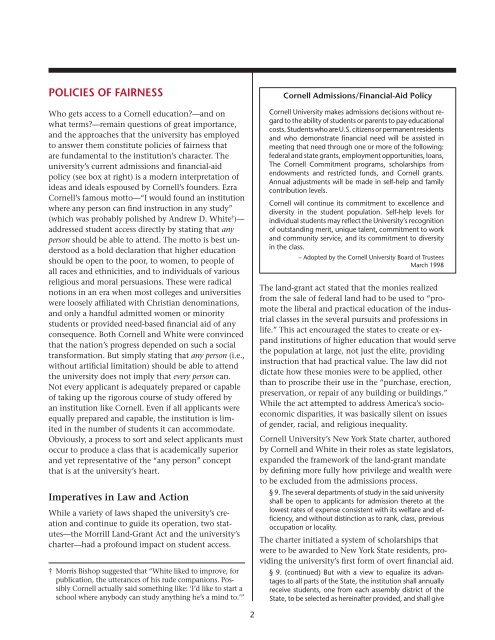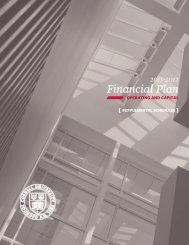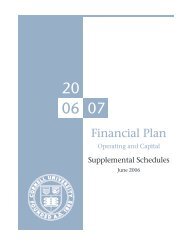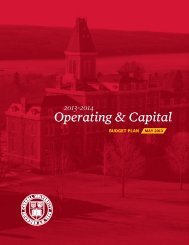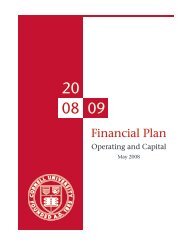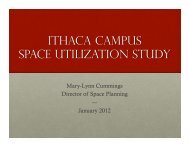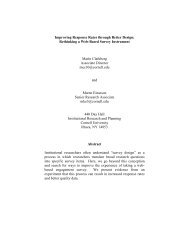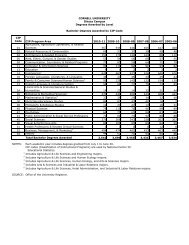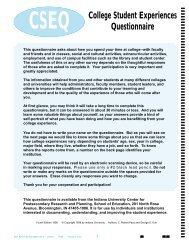UNDERGRADUATE STUDENT ACCESSINTRODUCTIONIn the August 15, 1868 edition <strong>of</strong> the New York Tribune,there appeared a letter to the editor entitled “ACard from Mr. <strong>Cornell</strong>—How a Poor Boy Can Pay forHis Education.” Here Ezra <strong>Cornell</strong> laid out his vision<strong>of</strong> how a third financial strut would be added totwo he had already crafted to support a new kind <strong>of</strong>university that would extend higher education to thenation’s working classes. The first two underpinningswere (a) the assignment to <strong>Cornell</strong> <strong>University</strong> <strong>of</strong> NewYork State’s portion <strong>of</strong> the proceeds from the recentlypassed Morrill Land Grant and (b) Ezra <strong>Cornell</strong>’s gift <strong>of</strong>a substantial endowment. <strong>Cornell</strong> knew that the combination<strong>of</strong> land-grant revenues and endowment giftswould not suffice to build and operate a new university.Whether or not students paid the minimal tuition(some received scholarships that covered that expense),they would incur room, board, transportation,and other costs in coming to Ithaca to study. Givensuch expenses, would working-class parents, especiallythose who had no personal or familial experiencewith higher education, even consider the feasibility ordesirability <strong>of</strong> sending their sons <strong>of</strong>f to college?According to Morris Bishop, the university’s initialenrollment had concerned <strong>Cornell</strong>. “One enormousuncertainty hovered over every decision. How manystudents would appear on the opening day? Toomany? Or too few? Fearing, perhaps, that there wouldbe too few, <strong>Cornell</strong> wrote [his] letter…” If that wasEzra <strong>Cornell</strong>’s concern, he need not have been so worried.The letter (which was widely reprinted in othernewspapers <strong>of</strong> the day) unleashed a flood <strong>of</strong> “sometwo thousand letters…mostly from totally unqualifiedyoung men or from their impecunious parents, whorecognized that to obtain a college education whileworking a quarter as hard as the Founder was a rarebargain,” and the university succeeded in enrolling412 students on its opening day. Carl Becker observedthat this represented “…the largest entering class everadmitted to any American college up to that time…more than twice as many as could be provided withlodging…and more than three times as many as couldbe conveniently taught in the class rooms available.”Thus was the university launched, grappling withchallenges <strong>of</strong> enrollment management, recruitment,admissions standards, and financial aid that are asgermane in 2005 as they were in 1868.THE CORNELL UNIVERSITY.A CARD FROM MR. CORNELL—HOW A POOR BOYCAN PAY FOR HIS EDUCATION.TO THE EDITOR OF THE TRIBUNE.SIR: The numerous appeals which I am receiving fromyoung men for assistance to enable them to pay their way whileobtaining an education at the <strong>Cornell</strong> <strong>University</strong>, impel me toreply through The Tribune. I would inform all who may desirethe information that, in organizing the <strong>University</strong>, the trusteesaimed to arrange a system <strong>of</strong> manual labor which, while itwould be compulsory upon none, would furnish all the students<strong>of</strong> the <strong>University</strong> with the opportunity to develop theirphysical strength and vigor by labor, the fair compensationfor which would pay the expenses <strong>of</strong> their education. <strong>Student</strong>swill be employed in cultivating and raising, on a farm <strong>of</strong> 300acres, the various productions best suited to furnish the collegetables. These will include livestock for producing milk, butter,and cheese, and to be killed for meat; grain for bread, andvegetables and fruits <strong>of</strong> all kinds suited to the climate and soil.Mechanical employment will be given to all in the machineshop <strong>of</strong> the <strong>University</strong>. This will be equipped with anengine <strong>of</strong> 25 horse power, lathes, planing-machines for ironand wood, and all the most improved implements and toolsfor working in iron and wood. Here they will manufacturetools, machinery, models, patterns, &c. The erection <strong>of</strong> theadditional buildings required for the <strong>University</strong> will furnishemployment for years to students in need <strong>of</strong> it. Therewill also be employment inlaying out, grading, road-making,and improving and beautifying the farm and grounds<strong>of</strong> the <strong>University</strong>. The work done by students will be paidfor at the current rates paid elsewhere for like services.The work will be done under the supervision <strong>of</strong> the pr<strong>of</strong>essors,and competent superintendents and foremen. Itwill be the constant aim <strong>of</strong> the trustees and faculty <strong>of</strong> the<strong>University</strong> to render it as attractive and instructive as possible,and especially to make it conductive to the health,growth, and physical vigor <strong>of</strong> the students, besides affordingthem the means <strong>of</strong> self-support and independence,while receiving all the advantages <strong>of</strong> the <strong>University</strong>.With such combined facilities for instruction and maintenance,all the expenses <strong>of</strong> a first-class faculty and <strong>of</strong> tuitionbeing paid by the endowment, I trust that no person who earnestlydesires to be thoroughly educated will find difficulty inbecoming so by his own exertions at the <strong>Cornell</strong> <strong>University</strong>.We already have students who entered three months in advance<strong>of</strong> the opening <strong>of</strong> the <strong>University</strong>, to avail themselves <strong>of</strong>the opportunity to earn two dollars per day “through haying andharvest, and thus make a sure thing <strong>of</strong> it.” Such boys will get aneducation, and will make their mark in the world in the use <strong>of</strong> it.In conclusion, I will assure the boys that if they will performone-fourth as much labor as I did at their ages, or as Ido now at 60 years <strong>of</strong> age, they will find no difficulty in payingtheir expenses while prosecuting their studies at Ithaca.Yours respectfully, EZRA CORNELL.Ithaca, N. Y., August 10, 1868.New York Tribune, August 15, 1868, page 41
POLICIES OF FAIRNESSWho gets access to a <strong>Cornell</strong> education?—and onwhat terms?—remain questions <strong>of</strong> great importance,and the approaches that the university has employedto answer them constitute policies <strong>of</strong> fairness thatare fundamental to the institution’s character. Theuniversity’s current admissions and financial-aidpolicy (see box at right) is a modern interpretation <strong>of</strong>ideas and ideals espoused by <strong>Cornell</strong>’s founders. Ezra<strong>Cornell</strong>’s famous motto—“I would found an institutionwhere any person can find instruction in any study”(which was probably polished by Andrew D. White † )—addressed student access directly by stating that anyperson should be able to attend. The motto is best understoodas a bold declaration that higher educationshould be open to the poor, to women, to people <strong>of</strong>all races and ethnicities, and to individuals <strong>of</strong> variousreligious and moral persuasions. These were radicalnotions in an era when most colleges and universitieswere loosely affiliated with Christian denominations,and only a handful admitted women or minoritystudents or provided need-based financial aid <strong>of</strong> anyconsequence. Both <strong>Cornell</strong> and White were convincedthat the nation’s progress depended on such a socialtransformation. But simply stating that any person (i.e.,without artificial limitation) should be able to attendthe university does not imply that every person can.Not every applicant is adequately prepared or capable<strong>of</strong> taking up the rigorous course <strong>of</strong> study <strong>of</strong>fered byan institution like <strong>Cornell</strong>. Even if all applicants wereequally prepared and capable, the institution is limitedin the number <strong>of</strong> students it can accommodate.Obviously, a process to sort and select applicants mustoccur to produce a class that is academically superiorand yet representative <strong>of</strong> the “any person” conceptthat is at the university’s heart.Imperatives in Law and ActionWhile a variety <strong>of</strong> laws shaped the university’s creationand continue to guide its operation, two statutes—theMorrill Land-Grant Act and the university’scharter—had a pr<strong>of</strong>ound impact on student access.† Morris Bishop suggested that “White liked to improve, forpublication, the utterances <strong>of</strong> his rude companions. Possibly<strong>Cornell</strong> actually said something like: ‘I’d like to start aschool where anybody can study anything he’s a mind to.’”<strong>Cornell</strong> Admissions/Financial-Aid Policy<strong>Cornell</strong> <strong>University</strong> makes admissions decisions without regardto the ability <strong>of</strong> students or parents to pay educationalcosts. <strong>Student</strong>s who are U.S. citizens or permanent residentsand who demonstrate financial need will be assisted inmeeting that need through one or more <strong>of</strong> the following:federal and state grants, employment opportunities, loans,The <strong>Cornell</strong> Commitment programs, scholarships fromendowments and restricted funds, and <strong>Cornell</strong> grants.Annual adjustments will be made in self-help and familycontribution levels.<strong>Cornell</strong> will continue its commitment to excellence anddiversity in the student population. Self-help levels forindividual students may reflect the <strong>University</strong>’s recognition<strong>of</strong> outstanding merit, unique talent, commitment to workand community service, and its commitment to diversityin the class.– Adopted by the <strong>Cornell</strong> <strong>University</strong> Board <strong>of</strong> TrusteesMarch 1998The land-grant act stated that the monies realizedfrom the sale <strong>of</strong> federal land had to be used to “promotethe liberal and practical education <strong>of</strong> the industrialclasses in the several pursuits and pr<strong>of</strong>essions inlife.” This act encouraged the states to create or expandinstitutions <strong>of</strong> higher education that would servethe population at large, not just the elite, providinginstruction that had practical value. The law did notdictate how these monies were to be applied, otherthan to proscribe their use in the “purchase, erection,preservation, or repair <strong>of</strong> any building or buildings.”While the act attempted to address America’s socioeconomicdisparities, it was basically silent on issues<strong>of</strong> gender, racial, and religious inequality.<strong>Cornell</strong> <strong>University</strong>’s New York State charter, authoredby <strong>Cornell</strong> and White in their roles as state legislators,expanded the framework <strong>of</strong> the land-grant mandateby defining more fully how privilege and wealth wereto be excluded from the admissions process.§ 9. The several departments <strong>of</strong> study in the said universityshall be open to applicants for admission thereto at thelowest rates <strong>of</strong> expense consistent with its welfare and efficiency,and without distinction as to rank, class, previousoccupation or locality.The charter initiated a system <strong>of</strong> scholarships thatwere to be awarded to New York State residents, providingthe university’s first form <strong>of</strong> overt financial aid.§ 9. (continued) But with a view to equalize its advantagesto all parts <strong>of</strong> the State, the institution shall annuallyreceive students, one from each assembly district <strong>of</strong> theState, to be selected as hereinafter provided, and shall give2


